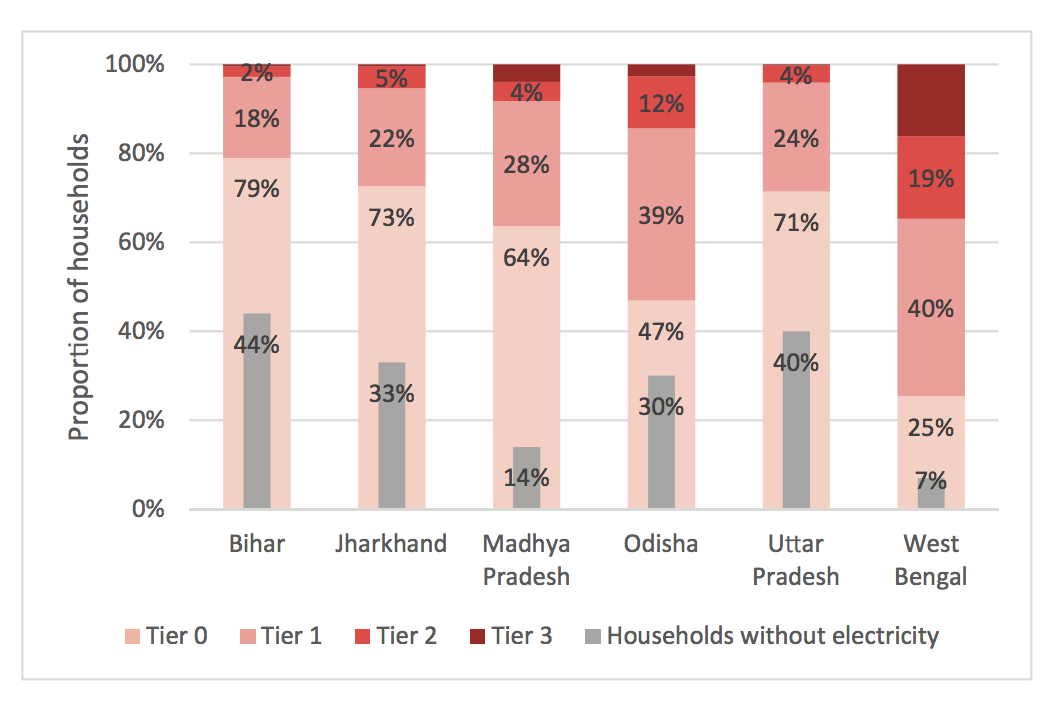Paper
Measuring Energy Access in India
Insights from applying a multi-tier framework in cooking energy and household electricity
Abhishek Jain, Johannes Urpelainen, Lucy Stevens
May 2016 | Energy Transitions
Suggested citation: Jain, A, J Urpelainen, L Stevens. 2016. Measuring Energy Access in India: Insights from applying a multi-tier framework in cooking energy and household electricity. Rugby, UK: Practical Action Publishing, http://dx.doi.org/10.3362/9781780446639
Overview
This paper, in collaboration with Columbia University, reports on the largest energy access survey ever conducted in India. The multi-tier framework approach used to measure access to household electricity and clean cooking energy provides a nuanced definition of energy access and reveals new insights about energy poverty in India. It also gives useful lessons for policy makers about where to target efforts.
The ACCESS survey covered a representative sample of 8,566 rural households across six states - Bihar, Jharkhand, Madhya Pradesh, Odisha, Uttar Pradesh and West Bengal - 714 villages and 51 districts.
Spread of households across electricity access tiers

Source: Author’s analysis
Key Findings
Household electricity access:
- West Bengal and Madhya Pradesh fared better than other states in providing electricity connections to as many households as possible.
- Though 69 per cent of households were electrified, only 37 per cent have any appreciable level of energy access.
- Two-third of households without electricity could not afford it or have chosen not to pay for connections.
- Unelectrified households have a mean monthly expenditure of INR 4,370, while electrified households have a mean monthly expenditure of INR 5,640, a 30 percent difference.
- About 5 percent of households surveyed have a decentralised electricity connection, which includes solar home systems or micro grids.
- Majority of micro-grids and solar lanterns are only designed to supply three to four hours of power per day. However, 19 per cent of solar home systems and 9 per cent of lanterns were supplying 12 hours of power.
Household electricity access:
- Less than 1 per cent of the rural population used improved biomass stoves, but 22 per cent had LPG.
- 1Only 14 percent of households in rural areas across the six states used BLEN (biogas/LPG/electricity/natural gas) as their primary source of cooking fuel.
- About 95 per cent of the respondents cited high upfront cost of LPG as the biggest barrier to adoption and 88 per cent said high recurring expenditure was a major barrier.
- Median monthly expenditure on cooking energy, for households relying entirely on LPG, was INR 383. However, households that stack fuels spent more on average at INR 436.
- There are considerable barriers to people buying a grid connection even when the grid is available in the area. Even where people are grid-connected, the performance is poor right across most of the six states. Off-grid solutions have not enjoyed widespread uptake.
- Although the proportion of households spending on fuel is far higher than expected, those with LPG are still occasionally relying on the collection and use of firewood. Despite state subsidies, access to LPG remains a privilege of a few.
Two thirds of households without electricity cannot afford or have chosen to not pay for connection; the high upfront cost of LPG was the biggest barrier to its adoption.







